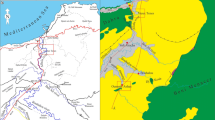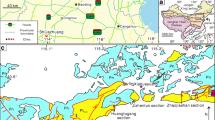Abstract
Carbonate concretions 10–20 cm below and immediately above the Cretaceous/Tertiary boundary at the Littig Quarry, Elgin, Texas, differ significantly from each other morphologically, petrographically, and isotopically. The Cretaceous Kemp Formation concretions consist of oblate spheroidal nodules made up of microspar and pseudospar. The δ13C and δ18O values of the microspar and pseudospar are relatively invariant (mean ± standard deviation: δ13Cav = −19.4 ± 0.4‰; δ18Oav = −1.6 ± 0.2‰, n=16), indicating concretion grew in a restricted zone beneath the sediment/water interface. δ18Oav coincides with that of Cretaceous/Tertiary planktonic forams reported from North American DSDP foram data, suggesting that the concretion formed from marine-derived waters and was not altered by freshwater. The occurrence of pyrite framboids and the low δ13C values suggest that the concretions grew under sulfate reducing conditions. In contrast, concretions from the Paleocene Littig Member of the Kincaid Formation consist of scattered microspar/pseudospar nuclei cemented by variably compacted, fine to very fine sandy, glauconitic, phosphatic, starved-basin sediment. The Littig Member concretions range in isotope composition from δ18O of −2.0 to −4.8‰. and δ13C of −20.5 to −10.3‰. The trend from high δ18O and low δ13C, to low δ18O and high δ13C, corresponds to increasing compaction and suggests that the Littig Member concretions grew continuously during burial rather than at a single depth like the Kemp Formation concretions. The increase in the13C isotope with increasing compaction is interpreted to indicate that the concretions formed during the shift from sulfate reducing to methanogenic conditions and in the early stages of methanogenesis. *** DIRECT SUPPORT *** A00QA020 00006
Similar content being viewed by others
References
AHARON, P., 1994, Carbon and oxygen isotope tracers of submarine hydrocarbon emissions: Northern Gulf of Mexico:Israel Journal of Earth Sciences, v. 43, p. 157–164.
BERNER, R. A., 1971, Principles of chemical sedimentology. McGraw-Hill, New York, 240 p.
BERNER, R.A., 1980, Early diagenesis: a theoretical approach. Princeton University Press, Princeton, 241 p.
BOERSMA, A., 1984, Campanian through Paleocene paleotemperature and carbon isotope sequence and the Cretaceous-Tertiary boundary in the Atlantic Ocean,in Berggren, W.A. and Van Couvering, J.A., (eds.), Catastrophes and earth history: the new uniformitarianism. Princeton University Press, Princeton, p. 247–277.
BROCK, T.D. and MADIGAN, M.T., 1988, Biology of microorganisms, 5th Edition. Prentice Hall, New Jersey, 835 p.
CLAYPOOL, G.E. and KAPLIN, I.R., 1974, The origin and distribution of methane in marine sediments,in Kaplan, I.R. (ed,), Natural gases in marine sediments. Plenum Press, New York, p. 99–140.
COLEMAN, M.L., 1993, Microbial processes: controls on the shape and composition of carbonate concretions:Marine Geology, v. 113, p. 127–140.
CRAIG, H., 1957, Isotopic standards for carbon and oxygen, correction factors for mass spectrometric analysis of carbon dioxide:Geochimica et Cosmochimica Acta, v. 12, p. 133–149.
CURTIS, C.D., PETROWSKI, C., and OERTEL, G., 1972, Stable carbon isotope ratios within carbonate concretions: a clue to place and time of formation:Nature, v. 235, p. 98–100.
CURTIS, C.D., COLEMAN, M.L., AND LOVE, L.G., 1986, Pore water evolution during sediment burial from isotopic and mineral chemistry of calcite, dolomite, and siderite concretions:Geochimica et Cosmochimica Acta, v. 50, p. 2321–2334.
DIX, G.R. and MULLINS, H.T., 1987, Shallow, subsurface growth and burial alteration of Middle Devonian calcite concretions:Journal of Sedimentary Petrology, v. 57, p. 140–152.
FRIEDMAN, I. and O’NEIL, J.R., 1977, Compilation of stable isotope fractionation factors of geochemical interest (Data of Geochemistry, Sixth Edition, Chapter KK). U.S. Geological Survey Professional Paper 440-KK, 12 p.
FROELICH, P.N., KLINKHAMMER, G.P., BENDER, M.L., LUEDTKE, N.A., HEATH, G.R., CULLEN, D., and DAUPHIN, P., 1979, Early oxidation of organic matter in pelagic sediments of the eastern equatorial Atlantic: suboxic diagenesis:Geochimica et Cosmochimica Acta, v. 43, p. 1075–1090.
GAMMILL, L.M., ADAMS, J.A.S., and CASEY, R.E., 1984, Potassium-40/Argon-40 age determinations on low-potassium glauconites near missing Cretaceous-Tertiary transition at Littig Pit, Travis County, Texas:American Association of Petroleum Geologists Abstracts.
GAUTIER, D.L., 1982, Siderite concretions: indicators of early diagenesis in the Gammon Shale (Cretaceous):Journal of Sedimentary Petrology, v. 52, p. 859–871.
GAUTIER, D.L., 1985, Interpretation of early diagenesis in ancient marine sediments,in Gautier, D.L., Kharaka, Y.K., and Surdham, R.C., (eds.) Relationship of organic matter and mineral diagenesis, SEPM Short Course Notes No. 17, p. 6–78.
GREGORY, R.T., DOUTHITT, C.B., DUDDY, I.R., RICH, P.V., and RICH, T.H., 1989, Oxygen isotopic composition of carbonate concretions from the lower Cretaceous of Victoria, Australia: implications for the evolution of meteoric waters on the Australian continent in a paleopolar environment:Earth and Planetary Science Letters, v. 91, p. 27–42.
HANSEN, T.A., 1982, Macrofauna of the Cretaceous/Tertiary boundary interval in East-Central Texas,in Maddocks, R.F. (ed.), Texas ostracoda: guidebook of excursions and related papers for the eighth international symposium on ostracoda, p. 231–237.
HENNESSY, J. and KNAUTH, L.P., 1985, Isotopic variations in dolomite concretions from the Monterey Formation, California,Journal of Sedimentary Petrology, v. 55, p. 120–130.
IRWIN, H., CURTIS, C., and COLEMAN, M., 1977, Isotopic evidence for source of diagenetic carbonate formed during burial of organic-rich sediments,Nature, v. 269, p. 209–213.
KAUFFMAN, E.G., 1984, The fabric of Cretaceous marine extinctions,in Berggren, W.A. and Van Couvering, J.A. (eds.), Catastrophes and earth history: the new uniformatarianism. Princeton University Press, Princeton, p. 151–246.
KOCUREK, G., 1978, Deltaic deposits in Kemp (Upper Cretaceous) and Kincaid (Paleocene) Formations, south-central Texas:Geological Society of America, South-Central Section, abstracts with program, v. 10, p. 21.
KOCUREK, G., 1983, The Cretaceous-Tertiary contact in South-Central Texas: a sedimentological view:Geological Society of America, South-Central Section, abstracts with program, v. 15, p. 33.
KOCUREK, G., and HANSEN, T.A., 1982, Sedimentological nature of the Cretaceous/Tertiary contact in South-Central Texas: a preliminary study.in Maddocks, R.F. (ed.), Texas Ostracoda: guidebook of excursions and related papers for the eighth international symposium on ostracoda, p. 223–230.
LAND, L.S., 1967, Diagenesis of skeletal carbonates:Journal of Sedimentary Petrology, v. 37, p. 914–930.
LOHMANN, K.C. and WALKER, J.C.G., 1989, The δ18O record of Phanerozoic abiotic marine calcite cements:Geophysical Research Letters, v. 16, p. 319–322.
MOZELY, P.S. and BURNS, S.J., 1993, Oxygen and carbon isotopic composition of marine carbonate concretions: an overview:Journal of Sedimentary Petrology, v. 63, p. 73–83.
RAISWELL, R., 1971, The growth of Cambrian and Liassic concretions:Sedimentology, v. 17, p. 147–171.
SASS, E., BEIN, A., and ALMOGI-LABIN, A., 1991, Oxygen-isotope composition of diagenetic calcite in organic-rich rocks: evidence for18O depletion in marine anaerobic pore water:Geology, v. 10, p. 261–286.
WEEKS, L.G., 1957, Origin of carbonate concretions in shales, Magdalena Valley, Columbia:Geological Society of America Bulletin, v. 68, p. 95–102.
WILKINSON, M., 1991, The concretions of the Bearreraig Sandstone Formation: geometry and geochemistry:Sedimentology, v. 38, p. 899–912.
Author information
Authors and Affiliations
Rights and permissions
About this article
Cite this article
Graber, E.R. Isotopic composition of diagenetic carbonate concretions at the Cretaceous-Tertiary boundary in south-central Texas, USA: Implications for their growth. Carbonates Evaporites 11, 59–69 (1996). https://doi.org/10.1007/BF03175785
Received:
Accepted:
Published:
Issue Date:
DOI: https://doi.org/10.1007/BF03175785




